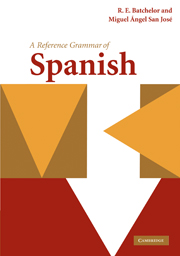Book contents
- Frontmatter
- Contents
- Preface/Prólogo
- Acknowledgments/Agradecimientos
- Abbreviations/Abreviaturas
- Introduction to the Spanish language/Introducción a la lengua española
- Part I
- Part II
- Part III
- Part IV
- Part V
- Part VI
- Part VII
- Part VIII
- 67 Demonstrative adjectives/Adjetivos demostrativos
- 68 Demonstrative pronouns/Pronombres demostrativos
- 69 Indefinite pronouns/Pronombres indefinidos
- Part IX
- Part X
- Appendix I Verb tables/ Tablas de verbos
- Appendix II Glossary/Glosario
- Bibliography/Bibliografía
- General index/Índice general
- Subjunctive index/Índice del subjuntivo
68 - Demonstrative pronouns/Pronombres demostrativos
from Part VIII
Published online by Cambridge University Press: 05 June 2012
- Frontmatter
- Contents
- Preface/Prólogo
- Acknowledgments/Agradecimientos
- Abbreviations/Abreviaturas
- Introduction to the Spanish language/Introducción a la lengua española
- Part I
- Part II
- Part III
- Part IV
- Part V
- Part VI
- Part VII
- Part VIII
- 67 Demonstrative adjectives/Adjetivos demostrativos
- 68 Demonstrative pronouns/Pronombres demostrativos
- 69 Indefinite pronouns/Pronombres indefinidos
- Part IX
- Part X
- Appendix I Verb tables/ Tablas de verbos
- Appendix II Glossary/Glosario
- Bibliography/Bibliografía
- General index/Índice general
- Subjunctive index/Índice del subjuntivo
Summary
Characteristics of demonstrative pronouns
As opposed to demonstrative adjectives (see Chapter 67), este, ese, aquel, and so on (this, that, that one, etc.), which apply to nouns, demonstrative pronouns actually replace nouns, and they agree in gender and number with the noun or nouns they replace.
éste, ésta, éstos, éstas (this one, these [ones])
ése, ésa, ésos, ésas (that one, those [ones]; closer to the speaker than aquél, etc.)
aquél, aquélla, aquéllos, aquéllas (that one, those [ones]; further from the speaker than ése, etc.)
Éste, ése, ésa, aquél, aquélla, and so on, are often used in comparisons, as in the following examples.
Este muchacho es más abusado (M)/listo que ése. (This boy is cleverer than that one.)
Estas novelas son más fáciles que aquéllas. (These novels are easier than those.)
As pronouns, the above forms may or may not have a written accent. There is no strict rule on this feature. It is argued that accents on pronouns avoid ambiguity. However, ambiguity is extremely rare. The RAE considers omission of the written accent permissible, but the Spanish newspaper El País, for instance, does not allow it. Furthermore, careful writers do seem to censure its absence. So it seems wiser to use it.
É;ste (este coche) es más caro que aquél. (This one is more expensive than that one.)
Ése es un autor de primera categoría. (That is a first-class author.)
[…]
- Type
- Chapter
- Information
- A Reference Grammar of Spanish , pp. 403 - 404Publisher: Cambridge University PressPrint publication year: 2010

